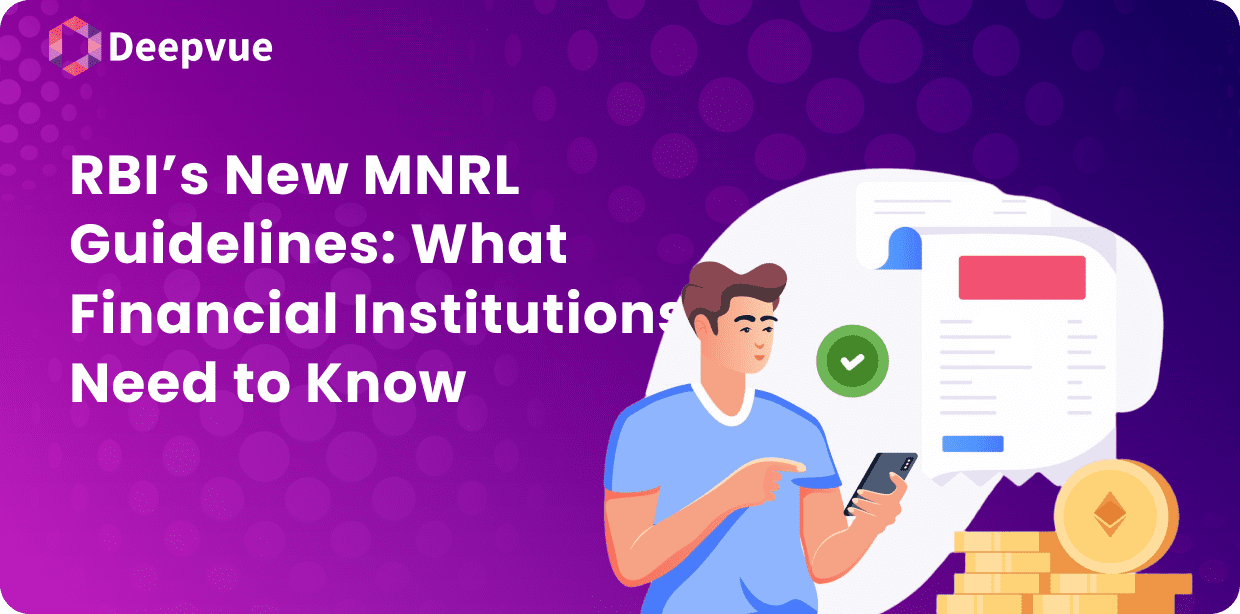In a fast-changing technology environment, financial institutions have to change to avoid risks. The Reserve Bank of India’s (RBI) new MNRL guidelines are both opportunities and challenges. It is essential to understand these guidelines for compliance and competitive advantage. The MNRL program improves customer transaction security and efficiency while ensuring regulatory compliance, with a focus on robust systems to safeguard consumer information. As the financial industry adapts to these developments, understanding and adopting MNRL standards is essential to sustain customer confidence.
This article focuses on major areas of the RBI’s MNRL guidelines including the key compliance obligations, the risks associated with not complying, and best practices for implementation.
Background of MNRL Technology
The MNRL functionality assists banks comply with the RBI’s requirement for mobile number verification. It links financial institutions to the Digital Intelligence Platform (DIP) under the management of the Department of Telecommunications. The platform maintains a database of numbers marked for disconnection or fraud. Using MNRL technology, banks can effectively verify customer mobile numbers to lower the risks of fraudulent activities.
Purpose of the MNRL
The MNRL aims to facilitate banks and financial institutions in conformity with RBI directions concerning mobile verification. Through their connectivity to the DIP, banks are able to quickly validate whether a mobile number of the customer is tainted by fraud or has been terminated. Unauthorized transactions can be prevented through this real-time verification. By regularly scanning their own databases with these numbers, banks can strengthen fraud control measures. The mandatory adoption of MNRL by March 31, 2025, reflects the urgency to comply to escape the legal and financial consequences.
Compliance Requirements for Financial Institutions
Financial institutions must comply with the Reserve Bank of India’s (RBI) expectations by using the Mobile Number Revocation List (MNRL) API. This compliance is key to mitigating fraud risks and enhancing customer confidence. Through automation of mobile number verification against the MNRL database, institutions will be able to achieve timely compliance without manual intervention. This helps entities make proper decisions, such as informing customers or investigating suspected activities. Ongoing monitoring and verification are required as mobile number statuses can change. These regulations cover the entire financial sector, ranging from big banks to fintech firms, pointing out the wide range of compliance.
Timeline for Implementation
The RBI has also prescribed March 31, 2025, as the timeline for financial institutions to implement MNRL regulations. On or before this date, banks, NBFCs, fintechs, and payment aggregators have to implement the MNRL API to prevent transactions and OTPs from reaching deactivated numbers. Automating compliance through API integration is the quickest way to comply by the deadline. Swift action is essential as the deadline nears, emphasizing the need for effective implementation strategies. This demand helps to minimize account abuse by ensuring transactions are not processed using expired or canceled numbers.
Accessing the MNRL Database
The MNRL database can be accessed via automated API integration or manual search on the Digital Intelligence Platform (DIP). The MNRL API facilitates real-time mobile number verification directly from the database. Manual lookups may be time-consuming, especially for organizations with large customer bases, and hence automation is essential. Integrating the MNRL API is crucial for fulfilling RBI requirements for mobile number verification, particularly in financial transactions. The database marks numbers for financial fraud or inactivity, so customer verification becomes a critical step before transactions.
| Access Method | Effectiveness | Best for |
| API Integration | High | Large customer bases |
| Manual Lookup | Low | Small databases or specific checks |
Automating KYC Processes
The MNRL API assists in enhancing Know Your Customer (KYC) processes by verifying customer mobile numbers against a permanently disconnected mobile number list. By integrating the API, banking institutions can automate KYC procedures, lessening manual verification. RBI’s MNRL regulations compliance is important for all financial institutions, including fintechs and startups, to minimize fraud risks. The MNRL API provides a convenient interface for integrating mobile number verification into current systems, enhancing KYC efficiency. The use of the API reduces the risk of scams on deactivated numbers, enhancing KYC security measures.
Communication Protocols with Customers
Financial institutions need to notify customers immediately if their registered mobile numbers are flagged or revoked, offering clear instructions for resolving the issue. The communication channels need to be secure, accessible, and multilingual to achieve effective reach and comprehension among the customers. Onboard integration of the MNRL system with the fraud monitoring system as well as CRM systems ensures smooth transfer of information and real-time alerting. The institutions need to have an efficient grievance redressal mechanism for addressing customer complaints against wrongly flagged or canceled numbers. Providing confirmed customer care numbers on platforms like official Contact Us pages and help desks reduces the risk of customers being targeted by scam calls.
Risks of Non-Compliance
Failure to comply with the RBI’s Mobile Number Revocation List (MNRL) regulations presents considerable risks. Financial institutions should comply with these regulations to avoid serious penalties, including service discontinuation and litigation, which could have devastating consequences. The effective date for compliance with the issuer and merchant MNRL regulations is March 31, 2025, increasing urgency for institutions to adjust and implement new practices. Failing to comply with guidelines poses risks of fraud as outdated numbers may be lost to criminals who may use them for financial crimes. This could cause sensitive information to leak, which compromises the security of the transaction. Being proactive is extremely important to build trust with a customer and secure financial resources.
Potential Penalties for Financial Institutions
Non-compliance with MNRL regulations can result in telecommunication sanctions, which may suspend SMS and call services for a period of two years. Financial institutions may be subjected to regulatory audits and fines, in addition to operational restrictions. Such penalties emphasize the necessity to incorporate MNRL in regular operations. Non-compliance can also lead to fraud liability if unauthorized transactions occur, resulting in legal consequences. Damage to customer trust is another risk, as clients may switch to entities that ensure secure financial dealings.
Impact on Customer Trust and Reputation
Applying the MNRL for anti-fraud purposes is key to instilling customer trust. Authentic and renewed phone numbers improve financial transaction security and reduce unauthorized access. Relaying authentic customer care numbers also encourages openness, reducing exposure to fraud. The inability to update the customer database can result in audits, fines, and limited business activities, leading to reputation loss. Cyber fraud evokes serious concerns regarding the integrity of sensitive information, undermining the trust of customers in financial institutions. Sustaining strong verification procedures is fundamental for long-term relations and the stability of the business.
Cyber Fraud Landscape
The Reserve Bank of India (RBI) has launched the Mobile Number Revocation List (MNRL) to fight cyber fraud. This vital instrument enhances fraud detection and safeguards financial institutions against money mule schemes. Through real-time exchange of updates across banks, telecommunication operators, and law enforcement agencies, MNRL improves the effectiveness of fraud detection. Coordination among these groups must be in place to deal with system weaknesses in financial transactions..
Fraudsters often use SIM swapping and number spoofing, posing significant risks. These tactics necessitate the implementation of MNRL for better protection. The RBI has set a compliance deadline of March 31, 2025, urging financial institutions to enhance their fraud detection and response strategies.
Establishing Internal Policies and Procedures
Internal procedures and policies are essential for keeping customer databases clean. Failing to establish proper procedures might result in sharing sensitive data, such as OTPs, with fraudsters. Therefore, verifying and tracking the mobile numbers used during transactions as well as in KYC exercises is essential.
- Report flagged numbers immediately.
- Track mobile numbers associated with transactions.
- Periodically update and audit systems.
Staff Training and Awareness Programs
Effective training programs are needed for employees to acquire the worth of the MNRL API so that fraud may be avoided. Awareness about trends from spoofed mobile numbers empowers employees to identify and defuse fraud. Training needs to highlight the worth of real-time access to data, facilitating decision-making in customer account management. Training employees in money mule behavior and canceled numbers enhance fraud prevention, leading to enhanced customer confidence.
- Comprehend mobile monitoring with MNRL.
- Recognize money mule signs.
- Prioritize real-time data options.
Frequently Asked Questions (FAQs)
How long would it take to implement the new MNRL guidelines in my organization?
The time of implementation may differ depending on the scale and current facilities of the organization. Institutions using the Deepvue MNRL API usually take a temporary implementation time of 1-3 days, considering it is a simple REST API that can be easily adapted into any web or mobile application. For more information, check the API documentation here.
What are the costs involved with adhering to the MNRL guidelines?
Organizations can start by creating a free Deepvue account. Regarding pricing, Deepvue offers an adaptive pay-as-you-go pricing model.
How will my institution be supported in transitioning to MNRL compliance?
Deepvue offers twenty-four-hour customer support and a specialized integration engineer for support.
What are the implications of not complying with the MNRL guidelines?
Non-compliance with the MNRL guidelines may lead to substantial financial penalties, reputational loss, and increased regulatory oversight. It is important to prioritize compliance to ensure the future of your institution. For more information on possible risks, get in touch with our Sales Team
Who can I contact for more information or specific questions related to MNRL guidelines?
For any further inquiries or specific queries regarding the MNRL guidelines, we invite you to contact Deepvue. We have a panel of experts ready to guide you through the labyrinth of compliance. Reach us at Deepvue Contact Information.








